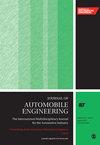Design and optimization of acoustic packages using RSM coupled with range analysis
IF 1.5
4区 工程技术
Q3 ENGINEERING, MECHANICAL
Proceedings of the Institution of Mechanical Engineers Part D-Journal of Automobile Engineering
Pub Date : 2024-07-26
DOI:10.1177/09544070241262353
引用次数: 0
Abstract
Acoustic packages are commonly used to reduce the mid-high frequency noise in the automobile, but fully characterizing their absorption and insulation mechanisms poses challenges. Introducing a data-driven approach to analyze their performance, existing research lacks clarity on the factors influencing acoustic package efficacy when constructing approximate models. To alleviate this, a method of optimizing the acoustic package by combining range analysis with a Response Surface Methodology (RSM) model is proposed in this paper. Initially, a validated Statistical Energy Analysis (SEA) model predicts automobile interior noise, pinpointing the dash panel as a key component for optimization through contribution analysis. Then, acoustic material tests are conducted to design the acoustic package. To compare the design scheme and the original scheme for the acoustic package in the automobile, the simulation and the test of the automobile ATF are performed and the automobile SEA model is verified through the test. Based on the range analysis, an RSM model is developed with the significant factors as input and the sound pressure level (SPL) of the driver’s head acoustic cavity as output. Genetic algorithm optimization is finally performed to obtain the optimized scheme within constrained thickness and weight. The results reveal that the acoustic package optimized scheme effectively improves the noise reduction effect in the mid-frequency range and decreases the weight of the acoustic package, which promotes the comprehensive performance of the acoustic package.利用 RSM 与范围分析相结合设计和优化声学组件
声学封装通常用于降低汽车中的中高频噪声,但要全面描述其吸收和隔绝机制却面临挑战。现有研究采用数据驱动的方法来分析其性能,但在构建近似模型时,对影响隔音包功效的因素缺乏清晰的认识。为了缓解这一问题,本文提出了一种通过将范围分析与响应面方法(RSM)模型相结合来优化隔音包的方法。首先,一个经过验证的统计能量分析(SEA)模型对汽车内部噪声进行预测,通过贡献分析将仪表板确定为优化的关键部件。然后,进行声学材料测试,设计声学套件。为了比较汽车声学套件的设计方案和原始方案,对汽车 ATF 进行了模拟和测试,并通过测试验证了汽车 SEA 模型。在范围分析的基础上,建立了以重要因素为输入、以驾驶员头部声腔的声压级(SPL)为输出的 RSM 模型。最后通过遗传算法进行优化,以获得厚度和重量受限的优化方案。结果表明,声学封装优化方案有效提高了中频范围内的降噪效果,并减轻了声学封装的重量,提升了声学封装的综合性能。
本文章由计算机程序翻译,如有差异,请以英文原文为准。
求助全文
约1分钟内获得全文
求助全文
来源期刊

CiteScore
4.40
自引率
17.60%
发文量
263
审稿时长
3.5 months
期刊介绍:
The Journal of Automobile Engineering is an established, high quality multi-disciplinary journal which publishes the very best peer-reviewed science and engineering in the field.
 求助内容:
求助内容: 应助结果提醒方式:
应助结果提醒方式:


